
Uttama, also known as Madhurantaka, was a Chola Emperor who ruled from 970 CE to 985 CE in present-day Tamil Nadu, India. According to Tiruvalangadu plates of Rajendra Chola, Madhurantaka Uttama's reign is placed after Aditya II. The latter may have been a co-regent of Parantaka II and seems to have died before he could formally ascend the throne. Uttama was the cousin of Parantaka II and was the son of the illustrious Sembiyan Mahadevi and Gandaraditya.
Kārkāthār is a Hindu caste in the Indian state of Tamil Nadu.
Vellalar is a group of castes in the Indian states of Tamil Nadu, Kerala and northeastern parts of Sri Lanka. The Vellalar are members of several endogamous castes such as the numerically strong Arunattu Vellalar, Chozhia Vellalar, Karkarthar Vellalar, Kongu Vellalar, Thuluva Vellalar and Sri Lankan Vellalar.
Arinjaya Chola was a ruler of the Chola kingdom. He was the third son of Parantaka I and the younger brother of Gandaraditya Chola, whom he is thought to have succeeded in about 956. Arinjaya Chola was succeeded by his son Sundara Chola as Madurantaka Uttama Chola was not old enough to ascend the throne. Arinjaya seems to have ruled for a very short time.

The period of the imperial Cholas in South India was an age of continuous improvement and refinement of Chola art and architecture. They utilised the wealth earned through their extensive conquests in building long-lasting stone temples and exquisite bronze sculptures, in an almost exclusively Hindu cultural setting.

The Velir were a royal house of minor dynastic kings and aristocratic chieftains in Tamilakam in the early historic period of South India. They had close relations with Chera, Chola and Pandya rulers through ruling and coronation rights. Medieval inscriptions claim that they belong to the Yadu dynasty.
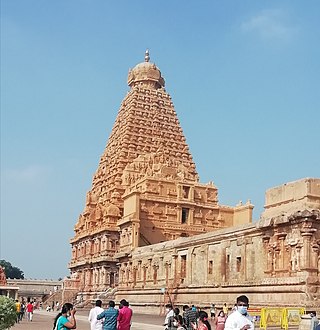
Brihadishvara Temple, called Rajarajesvaram by its builder, and known locally as Thanjai Periya Kovil and Peruvudaiyar Kovil, is a Shaivite Hindu temple built in a Chola architectural style located on the south bank of the Cauvery river in Thanjavur, Tamil Nadu, India. It is one of the largest Hindu temples and an exemplar of Tamil architecture. It is also called Dakshina Meru. Built by Chola emperor Rajaraja I between 1003 and 1010 CE, the temple is a part of the UNESCO World Heritage Site known as the "Great Living Chola Temples", along with the Chola-era Gangaikonda Cholapuram temple and Airavatesvara temple, which are about 70 kilometres (43 mi) and 40 kilometres (25 mi) to its northeast respectively.
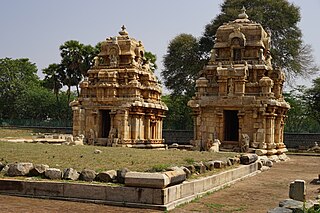
Irunkōvēl, also known as Irungkōvēl, Irukkuvēl, and Ilangōvēlir, was a title of the Irunkōvēl line of Velir kings. The Irunkovel line of kings ruled over Konadu identified with the Kodumbalur and surrounding areas in ancient Tamilakkam. They trace their lineage to the clan of Krishna; one of the inscriptions at Kodumbalur belonging to one of the kings in the Irunkovel line, namely Tennavan Irunkōvēl alias Maravan Bhutiyar, declares that he belonged to the kshatriya dynasty which is descended from Yadu. The Moovar Koil record of Irukkuvel chief Boothi Vikramakesari lauds his father, Samarabirama, as Yadu-vamsa-ketu.
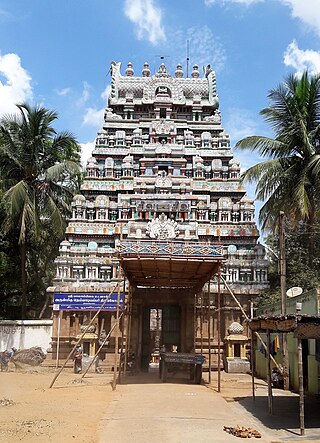
Neyyadiappar Temple, Tillaistanam is a Hindu temple dedicated to Shiva located in the village of Thillaisthanam also known as Tillaisthanam or Thiruneithanam in Tamil Nadu, India. It is significant to the Hindu sect of Shaivism as one of the Saptasthanam, the seven temples associated with Aiyarappar temple in Thiruvaiyaru. Shiva is represented by the lingam in the form of Neyyadiappar. His consort Parvati is depicted as Piraisoodi Amman. The presiding deity is revered in the 7th century Tamil Shaiva canonical work, the Tevaram, written by Tamil saint poets known as the nayanars and classified as Paadal Petra Sthalam.
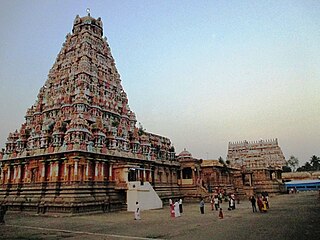
The Kampaheswarar Temple or kampa-hara-ishvarar is a Hindu temple dedicated to the god Shiva. It is situated in Thirubuvanam, a village in Thanjavur district in the South Indian State of Tamil Nadu, on the Mayiladuthurai-Kumbakonam road. Shiva is worshiped as "Kampahareswarar" as he removed the quaking of a king who was being haunted by a Brahmarakshasa. It was built by Kulothunga Chola III and is considered the last of the four masterpieces built during the Medieval Chola era.
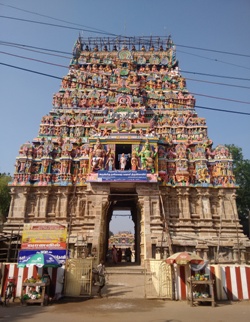
Nageswaraswamy Temple, Kumbakonam is a Hindu temple dedicated to Shiva located in Kumbakonam in Thanjavur district, Tamil Nadu, India. The presiding deity is revered in the 7th-century Tamil Saiva canonical work, the Tevaram, written by Tamil poet saints known as the nayanars and classified as Paadal Petra Sthalam. The temple is counted as the earliest of all Chola temples. Shiva in the guise of Nagaraja, the serpent king..
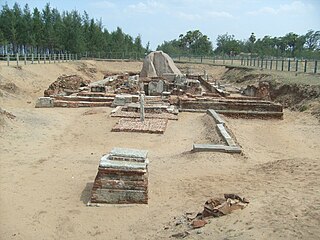
The Murugan Temple at Saluvankuppam, Tamil Nadu, India, is a shrine dedicated to Tamil Hindu deity Murugan. Archaeologists believe that the shrine, unearthed in 2005, consists of two layers: a brick temple constructed during the Sangam period and a granite Pallava temple dating from the 8th century CE and constructed on top of the brick shrine making it the oldest temple in india. The Archaeological Survey of India (ASI) team which conducted the excavation believe that brick temple could be the oldest of its kind to be discovered in Tamil Nadu.
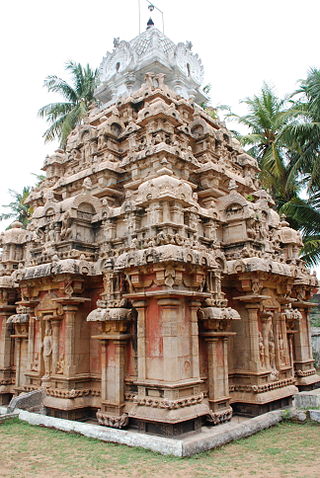
Tirupullamangai or Thirupullamangai is a Hindu temple dedicated to Lord Siva located in Pasupathikoil, Papanasam taluk of Thanjavur district, Tamil Nadu, India. It is one of the shrines of the 275 Paadal Petra Sthalams - Shiva Sthalams glorified in the early medieval Tevaram poems by Tamil Saivite Nayanar Tirugnanasambandar.
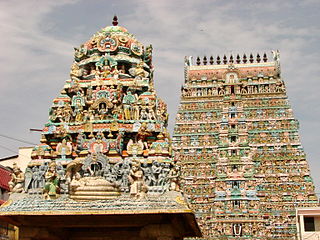
Tamil Nadu is known for its ancient temple architecture. Nearly 33,000 ancient temples, many at least 800 to 2000 years old, are found scattered all over Tamil Nadu. As per Tamil Nadu Hindu Endowments Board, there are 38,615 temples. Most of the largest Hindu Temples reside here. Studded with complex architecture, a variety of sculptures, and rich inscriptions, the temples remain the very essence of the culture and heritage of Tamil land, with historical records dating back to at least 3,000 years.
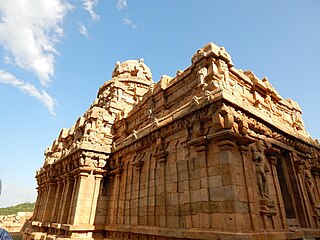
Vijayalaya Choleeswaram in Narthamalai, a panchayat town in Pudukottai district in the South Indian state of Tamil Nadu, India, is a temple dedicated to the Hindu god Shiva, Vishnu and houses the 8th century Jaina Abode. The temple is considered one of the oldest stone temples in South India. The other portions of Narthamalai houses the 8th century Jaina Abode, the Aluruttimalai Jain Caves. The Temple is Constructed in the Dravida style and rock cut architecture, the temple is believed to have been built during the 9th century by Mutharaiyar dynasty kings, the cardinals of Pallavas, with later expansion from the Cholas. The rock-cut architecture is an early example of Cholan Art, continuing the tradition of the Pallavas.

Avanibhajana Pallaveshwaram temple also called Stambeswarar Temple is a Hindu temple dedicated to Shiva, located in the town of Seeyamangalam, Tiruvannamalai district in Tamil Nadu, India. The temple is constructed in Rock-cut architecture by the Pallava king Mahendravarman I during the 7th century. The cave temple had later additions from the Chola and Vijayanagar Empire.

Kunnandarkoil Cave Temple in Kunnandarkoil, a village in Pudukottai district in the South Indian state of Tamil Nadu, is dedicated to the Hindu god Shiva. Constructed in Rock-cut architecture, the temple is believed to have been built during the 8th century by Muttaraiyar kings, the cardinals of Pallavas, with later expansion from the Vijayanagar Empire. The rock-cut architecture in the temple is a specimen of the late Pallava Art and an early example of Chola Art. The temple has various inscriptions from Cholas, Chalukyas, Pandyas and Vijayanagar Empire. The temple is considered one of the oldest stone temples in South India. The temple is maintained and administered by Department of Archaeological Survey of India as a protected monument.

Trilokyanatha Temple, also called Thirupparuthikundram Jain temple or Jeenaswamy Trilokyanathar temple, is an 8th-century Digambara Jain temple in Thiruparthikundram, in northeast Kanchipuram in Tamil Nadu, India. The suburb and the area around this temple is also called Jain Kanchi. The stone temple is dedicated to the Jain Tirthankaras, but is notable for integrating Hindu deities with Jain deities within the premises of the temple, particularly as Ksetrapalas. Constructed in Dravidian architecture, the temple was built during the reign of Narasimhavarman II of the Pallava dynasty. The temple was expanded by the Jain community with financial support of Medieval Cholas, later Pallavas and Vijayanagar kings.

Boothi Vikramakesari was a Velir Irukkuvel commander of the Chola Empire during Sundara Chola's reign. He is best remembered for building the Moovar Koil temple complex, a collection of three temples in the village of Kodumbalur, 36 kilometres from Pudukkottai in Tamil Nadu, India. His family was related to the Cholas by marriage. His mother was Chola princess Anupama, the daughter of Parantaka I, while his father was Samarabirama who belonged to the Velir clan.





















